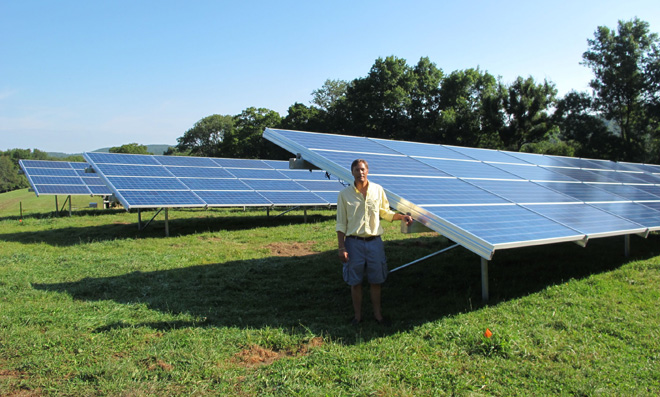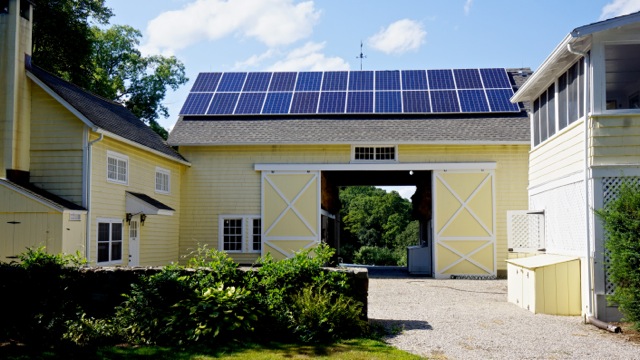
Sun, Sun, Sun-Here it comes!
By John Campbell, Board member
Sunlight to electric current! It’s amazing! Photovoltaics (using sunlight to produce electric current) provide an elegant conversionof sunlight to energy with no moving parts and no environmental emissions. As the cost of solar panels decreases, the incentives to use solar energy continue to rise.
In keeping with New Pond Farm’s mission statement, On every acre, in all we do, we plant seeds for a lifetime of active engagement with the natural world, the Board of Directors decided to generate a portion of its energy needs by installing a photovoltaic system at the farm. Two barn roofs now hold solar panels, and a “ground array” is located adjacent to the existing composting facility. The roof panels are relatively unobtrusive. They are approximately 3’ X 5’ X 1’ and will be placed so as to maximize sunlight exposure. The “ground array” (a description that sounds daunting) is approximately 40’ x 60’ x 6’. There is a certain smile-provoking symmetry about having photovoltaics positioned next to a shed of cow manure.
A real-time display of the conversion of sunlight to electricity was included in the solar project and can be viewed by visitors to our Learning Center (or visit the link below*). The number and location of the panels was decided upon after consultation with photovoltaic experts, our amazing professional staff, the Board of Directors and the Zoning Commission.
Build out costs are being defrayed by a number of strategies including tax incentives, third party underwriting and local power producer incentives. This photovoltaic project was completed in October 2014. There will be not only a net savings in electrical costs as a result of this project, but a real reduction of New Pond Farm’s carbon footprint. We believe the use of solar energy is a responsible use of technology at New Pond Farm.
If south facing access to the sun is available to you, photovoltaics may be a viable way to reduce your carbon footprint.
(*) Please learn more about our
SolarEdge monitoring Here
Words from our project underwriter, Ben Baker of Star Power:
Ten years ago, as the issue of Global Climate Change was emerging as a major world-wide problem, I became interested in solar photovoltaics, a carbon free source of electric generation. Clearly, cost was the major deterrent to solar power and the reason it has not been more embraced by the short-sighted US economy. But with the arrival of government incentives and a few pioneers willing to invest for the long term, the picture began to change. Several companies embraced a business model based on the Power Purchase Agreement (PPA) wherein building owners allowed others to construct solar generating systems on their buildings if they could purchase discounted electricity.
Government incentives and the emerging market for carbon credits offered these solar developers and their forward thinking customer-partners acceptable returns. Aware of the small commercial rooftops that are all around us and understanding that small buildings represent a major portion of our electric use, I began to wonder if the PPA model could work on a much smaller scale I knew I would need customers who were not likely to move for at least a decade; I wanted to avoid negotiating with the buyers of buildings housing my equipment. Homeowners and small businesses are mobile and move often. On the other hand, non-profits, especially education centers and churches, rarely move. They have loyal communities of people who spread the word about new projects – perfect for my mission of promoting solar power. Non-profits cannot take advantage of tax credits and depreciation deductions. Finally, non-profits are often very aware of environmental issues and interested in ways that help promote solutions. I knew I would need customers who were not likely to move for at least a decade; I wanted to avoid negotiating with the buyers of buildings housing my equipment. Homeowners and small businesses are mobile and move often. On the other hand, non-profits, especially education centers and churches, rarely move. They have loyal communities of people who spread the word about new projects – perfect for my mission of promoting solar power. Non-profits cannot take advantage of tax credits and depreciation deductions. Finally, non-profits are often very aware of environmental issues and interested in ways that help promote solutions.

